®
Personal Computer
Reference Manual
Model No. CF-T1 Series
Contents
Read Me First................................................................2
Key Combinations........................................................3
LED Indicators..............................................................6
Touch Pad.....................................................................7
Touchscreen* .............................................................11
Display Rotation Tool*...............................................14
Standby/Hibernation Functions................................15
Security Measures .....................................................19
Computing on the Road ............................................23
Battery Power.............................................................25
SD-MovieStage Windows XP ........................................30
PC Cards.....................................................................32
SD Memory Card/MultiMedia Card ...........................34
RAM Module ...............................................................44
External Display ........................................................45
USB Devices ..............................................................48
Modem ........................................................................50
LAN..............................................................................52
Setup Utility ................................................................54
Technical Information................................................61
DMI Viewer..................................................................62
List of Error Codes.....................................................63
Dealing with Problems (Advanced) .........................65
* Only for models with touchscreen
When the cursor is moved to an item under [Contents] or to page number (green display), the shape of the
cursor will change to
. Under this condition, if characters are tapped (or a click is made), the corresponding
page in the Reference Manual will be displayed.
We recommend that this Reference Manual be printed.
�
Read Me First
2
G If the user has logged on without the administrator authority, some functions may not be
executable, and some screens may not be displayed as shown in this manual. If this
happens, log on with the administrator authority to enable these functions.
G This manual covers two types of models, as distinguished by the type of LCD screen
(models with touchscreen and models without touchscreen).
G Confirm the latest information on optional products in catalogs, etc.
Illustrations and Terminology in this Reference Manual
NOTE
CAUTION
WARNING
Windows 2000
Windows 2000
Windows 2000
Windows 2000
Windows XP
Windows XP
Windows XP
Windows XP
Enter
Fn + F5
: NOTE provides a useful fact or helpful information.
: CAUTION indicates a condition that may result in
minor or moderate injury.
: WARNING indicates a hazard that may result in
moderate or serious injury.
:
:
Information for Microsoft
Professional users.
®
Windows 2000
®
Information for Microsoft
Professional users.
®
Windows XP
®
: This illustration means to press [Enter] key.
: This illustration means to press and hold [Fn] key,
then press [F5] key.
[Start]* - [Run]
: This illustration means to select [Start]*, then to
For U.S.A. and Canada
For U.S.A. and Canada
For U.S.A. and Canada
For U.S.A. and Canada
For Hong Kong
For Hong Kong
For Hong Kong
For Hong Kong
select [Run].
For some applications, you may need to select.
*Windows XP
Windows XP : [start]
Windows XP
Windows XP
Information for CF-T1RxxxxxM users.
Information for CF-T1RxxxxxH users.
:
:
: This illustration means to refer to the Operating
Instructions.
G Windows 2000 screens are used in this manual when no specific OS notes are
required.
G Some of the illustrations in this manual may differ slightly in shape from the actual items
in order to make the explanation easier to understand.
G About the terminology used in this manual and the Setup Utility concerning the internal
LCD and an external display
This manual and the
Setup Utility
Simultaneous display
[Intel(R) 82830M Graphics
Controller Properties]*
Intel(R) Dual Display Clone
To display the same screen on
both the internal LCD and exter-
nal display
* Windows 2000 : Select [Start] - [Settings] - [Control Panel] - [Intel® Extreme Graphics].
Windows XP
: Select [start] - [Control Panel] - [Other Control Panel Options] - [Intel®
Extreme Graphics].
�
Key Combinations
3
CAUTION
G Do not press the following key combinations while using the touch pad (external mouse), touchscreen (only for mod-
els with touchscreen) or other keys.
NOTE
G Do not press the following key combinations until you log on to Windows and the hard disk drive indicator turns off.
Note, however, that the key combinations Fn + F1, Fn + F2 and Fn + F3 are operable in the Setup Utility.
G The key combinations below may not work while some applications are running. Besides, the popup window may not
be displayed depending on the state of the application you are using (e.g., when [Command Prompt] screen is set to
“Full Screen”).
Popup Window
(Displayed after logging on to
Windows)
Key
Functions
Function Descriptions
Fn + F1
Fn + F2
LCD brightness control
(down)
LCD brightness control
(up)
Fn + F3
Display change
Pressing this key combination adjusts the
brightness of LCD. The brightness setting is
stored in memory separately under the condi-
tion the AC adaptor is connected and under the
condition the AC adaptor is not connected.
By pressing this key combination, you can
select either an external display, LCD or
simultaneous. ( page 45)
This combination does not work when
[Command Prompt] screen is set to “Full
Screen”.
CAUTION
G Do not press another key until the dis-
play destination has been completely
switched.
G Do not press this key combination while
MPEG files are playing.
NOTE
G Windows XP
When switching to a different user with
the Fast User Switching function, this key
combination may not work. In this case,
log on with the administrator authority
again, not using the Fast User Switching
function, and try the operation once
more.
�
Key Combinations
Key
Functions
Function Descriptions
Fn + F4
Speaker on/off switch
Pressing this key combination turns on/off
audio from the internal speaker and headphone
jack.
NOTE
G Disabling the speaker will also disable
the warning beep.
G Speakers connected to the USB port
cannot be muted.
Fn + F5
Fn + F6
Volume control (down)
Volume control (up)
Pressing this key combination adjusts the
volume of the internal speaker and headphone
jack.
Fn + F7
Power off using the
standby function
Fn + F9
Remaining capacity of the
battery pack
Fn + F10
Power off using the
hibernation function
NOTE
G This key combination cannot be used to
adjust the volume of the warning beep or
speakers connected to the USB port.
Pressing this key combination causes the
current status of the computer to be saved to
memory, and powers off the computer.
( page 15)
Pressing this key combination displays the
remaining battery capacity on the screen.
( page 26)
Pressing this key combination causes the
current status of the computer to be saved to
the hard disk, and powers off the computer.
( page 15)
4
Popup Window
(Displayed after logging on to
Windows)
OFF (MUTE)
ON
Remaining capacity (%)
display.
Battery pack is not
inserted.
�
Key Combinations
Hotkey Settings
5
There are two Fn key functions as follows:
GFn key lock function
After Fn is pressed once, it stays in the “pressed” position until another key is pressed.
This is convenient when it is difficult to press two buttons simultaneously.
GPopup windows display ON/OFF
1 Run the Hotkey Settings.
Windows 2000 : Select [Start] - [Programs] - [Panasonic] - [Hotkey Settings].
Windows XP
: Select [start] - [All Programs] - [Panasonic] - [Hotkey Settings].
A
2 Set the parameters.
A.Use Fn key lock
Add the check mark if you want to enable the Fn key lock function.
The following Fn key lock function will then be enabled.
To use Fn only once:
1 Press Fn once. (Locked)
2 Press another key for combination.
B C
To use Fn successively:
(Lock released)
1 Press Fn twice. (Locked)
2 Press another key for combination.
Fn key remains locked until Fn is pressed once
more.
B.Notification
This setting is only available when [Use Fn key lock] is checked.
[Make sounds when Fn key is pressed]*:
Notifies the user with a sound when Fn is pressed, locked, or released.
*(If MUTE is set, you will not hear a beep.)
[Show status on screen]:
Displays the Fn key status on the taskbar.
: Fn is locked
: Fn is not locked
C.Disable popup
Add the check mark if you want to turn the popup window display function OFF.
The full-screen display of [Command Prompt] screen or MPEG files may change to
a window display if Fn + Fx* are pressed. To prevent this, turn the popup window
display function OFF.
3 Select [OK].
NOTE
G The Fn key lock function also works with Fn and other keys (e.g., , ) aside from
Fx*.
G Each user can select separate settings for whether or not to use the Hotkey settings.
* “Fx” indicates any function key from F1 to F10.
�
LED Indicators
6
Power status
Not lit
GreenG
Blinking greenG : Standby mode
: Power off / Hibernation mode
: Power on
Battery pack status
Not lit
OrangeG*
GreenG*
RedG
Blinking redG*
Blinking orangeG*
: AC adaptor not connected or charging not being
performed.
: Charging in progress.
: Charging finished.
: Battery is low.
(remaining battery capacity is approx. 9% or less).
: Battery pack or charging malfunction.
: Unable to recharge due to violation of temperature
limits. The ambient temperature is outside the
allowable range. Once the allowable range requirement
is satisfied, charging begins automatically.
Caps Lock
This indicator lights green when Caps Lock is pressed. Subsequent
non-shifted input is capitalized.
NumLk (Numeric key) This indicator lights green when NumLk is pressed. This causes a portion
of the keyboard to function as a numeric keypad. [Enter] key functions
differently depending on the application.
ScrLk (Scroll lock)
This indicator lights green when ScrLk is pressed. Scroll lock functions
differently depending on the application.
Hard disk drive status This indicator lights when the hard disk drive is accessed.
SD memory card sta-
tus
This indicator lights when the SD memory card or MultiMedia Card is
accessed.
* When the AC adaptor is connected.
�
Touch Pad
7
Use the touch pad to move the cursor on the display and perform normal computer
operations.
NOTE
G By design the touch pad is to be used with a finger tip only. Therefore, do not use
any implement which causes damage on the work surface.
A.Work Surface (Touch Pad)
B.Left Button
C.Right Button
Function
Moving the Cursor
Operation
Move the tip of your finger lightly over the
work surface.
Tapping/Clicking
Double-Tapping/
Double-Clicking
Dragging
Scroll
NOTE
tapping
or
clicking
double-tapping
or
double-clicking
or
While holding down
the button, moving
your finger on the
work surface.
Two quick taps, but
on the second tap
leaving your finger
down (applying
pressure) and mov-
ing it on the work
surface.
page 8
G Refer to [Mouse Properties]* for information on basic operations other than the above.
*Windows 2000 : Select [Start] - [Settings] - [Control Panel] - [Mouse].
Windows XP
: Select [start] - [Control Panel] - [Printers and Other Hardware] -
[Mouse].
G The help message in [Settings] for [Mouse Properties] - [Device Settings] will be
displayed in the same language as the one set for [Control Panel] - [Date, Time,
Language, and Regional Options] - [Regional and Language Options] - [Standards
and formats].
�
Touch Pad
8
Using the Touch Pad Utility
How to Scroll
The Touch Pad Utility enables you to scroll easily by tracing a circle around the touch pad.
NOTE
G Depending on the application software, the scroll operation may differ, or the scroll
function may not operate properly.
1 Select the screen you want to scroll.
2 Position the cursor over the area you want to scroll.
3 Trace a circle around the edge of the touch pad as indicated in
the following diagrams.
To scroll down (trace clockwise)
To scroll up (trace counter-clockwise)
Scrolling will begin more easily if you start from the position marked by the
trace as indicated by the arrow.
and
4 Once scrolling has begun, continue to trace a circle on the touch
pad without removing your finger from the pad.
GAs long as you are tracing a circle, you can continue scrolling using any position
on the touch pad. It is not necessary to trace a circle around the edge of the pad.
GTo scroll in the opposite direction, trace a circle in the opposite direction without
removing your finger from the touch pad.
5 When you are finished scrolling, remove your finger from the
touch pad.
Hints for Easier Touch Pad Operation
GYou can change various touch pad settings using the following procedure:
Windows 2000:
[Start] - [Programs] - [Panasonic] - [Touch Pad Utility Setting]
Windows XP:
[start] - [All Programs] - [Panasonic] - [Touch Pad Utility Setting]
Settings can be changed for the following functions:
• Use Touch Pad function (On/Off)
Display icon in task tray (On/Off)
Animated icon in task tray (On/Off)
Rotate icon when wheel is operated (On/Off)
�
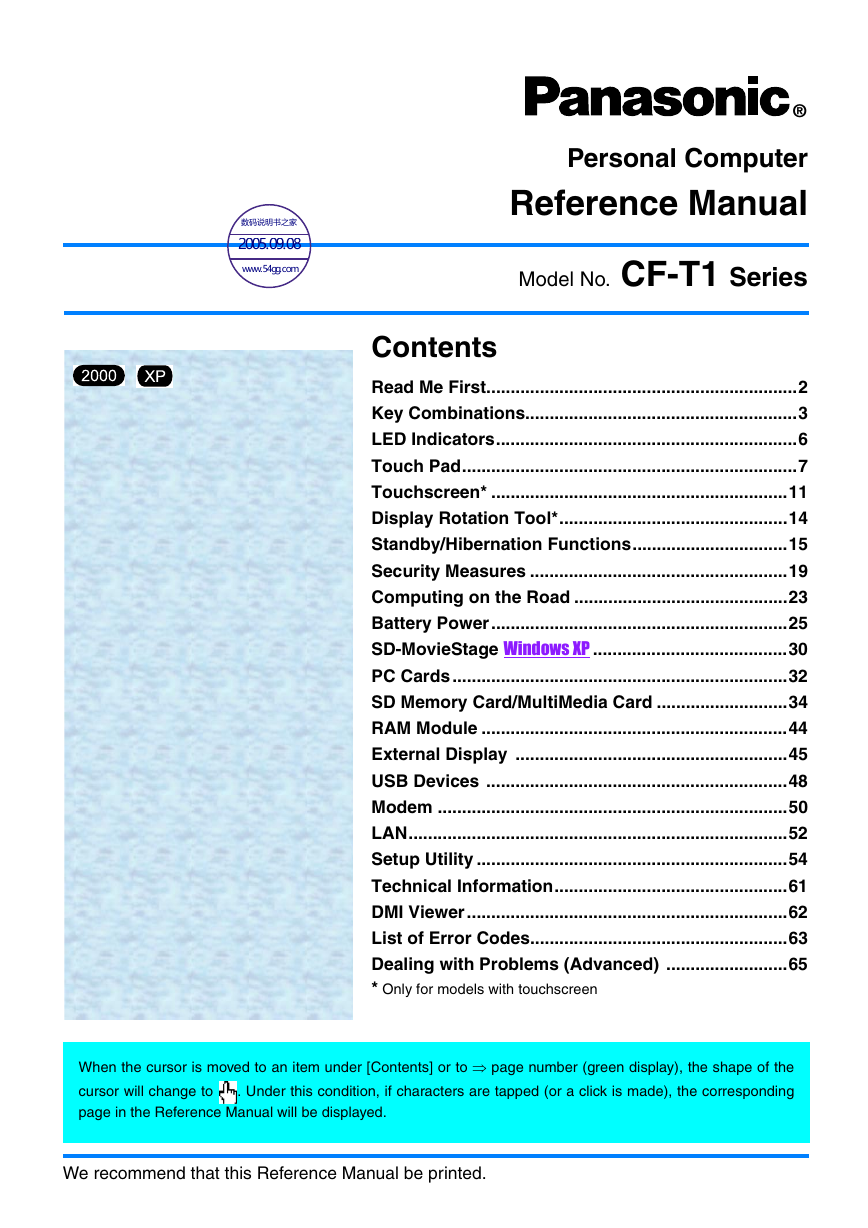
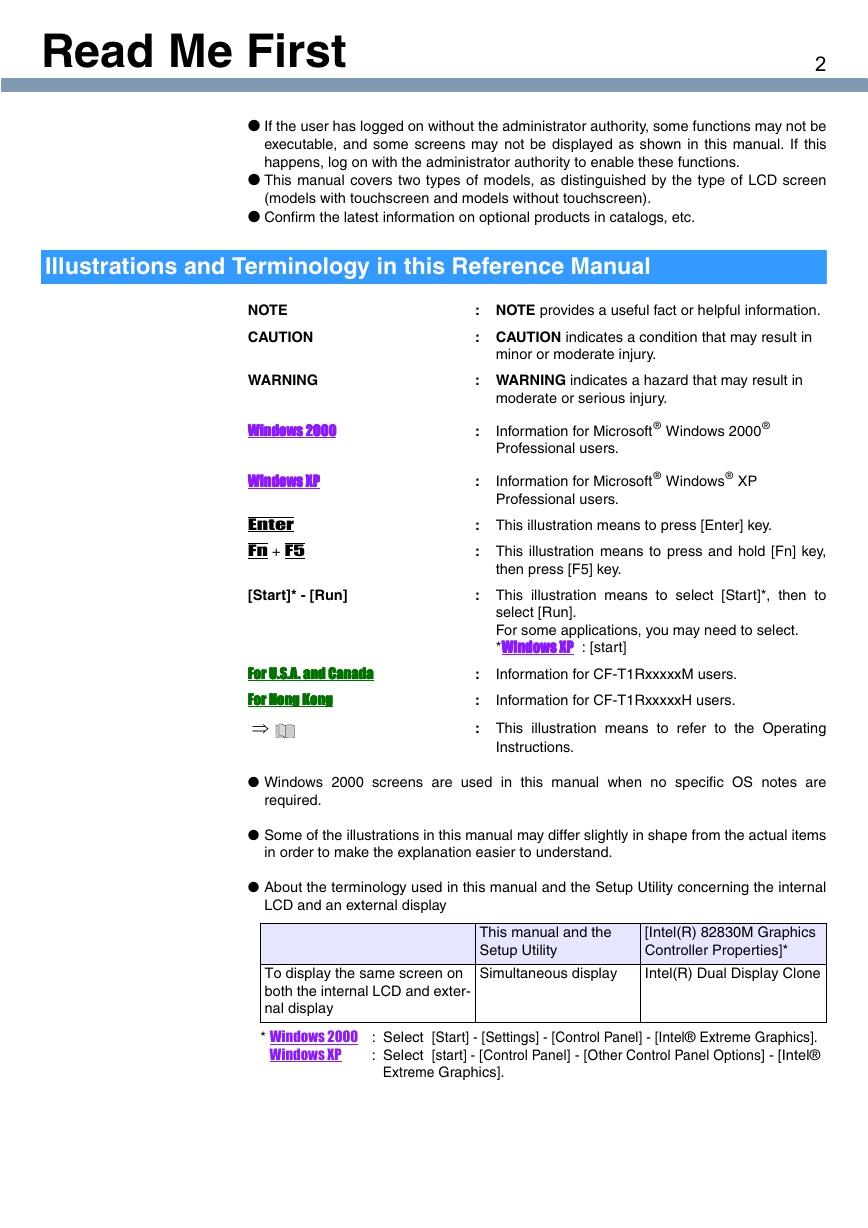
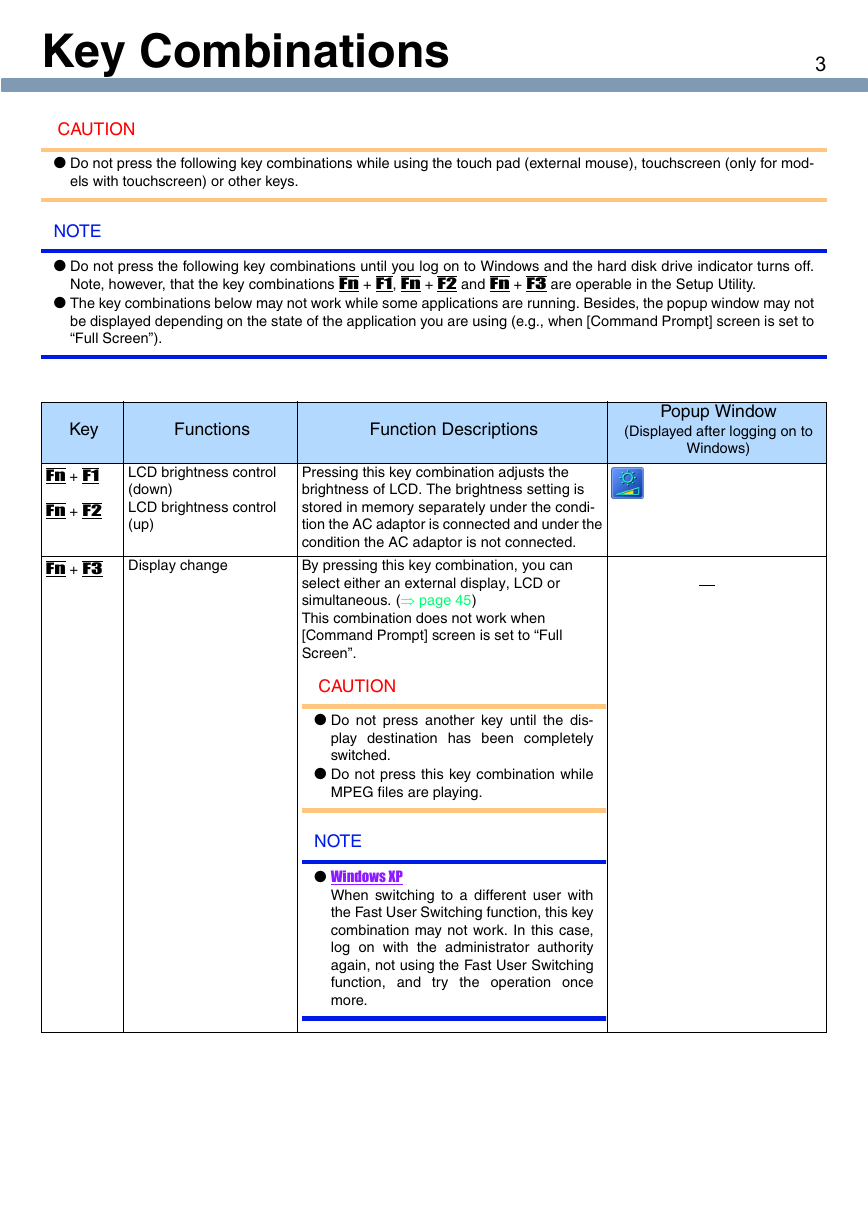
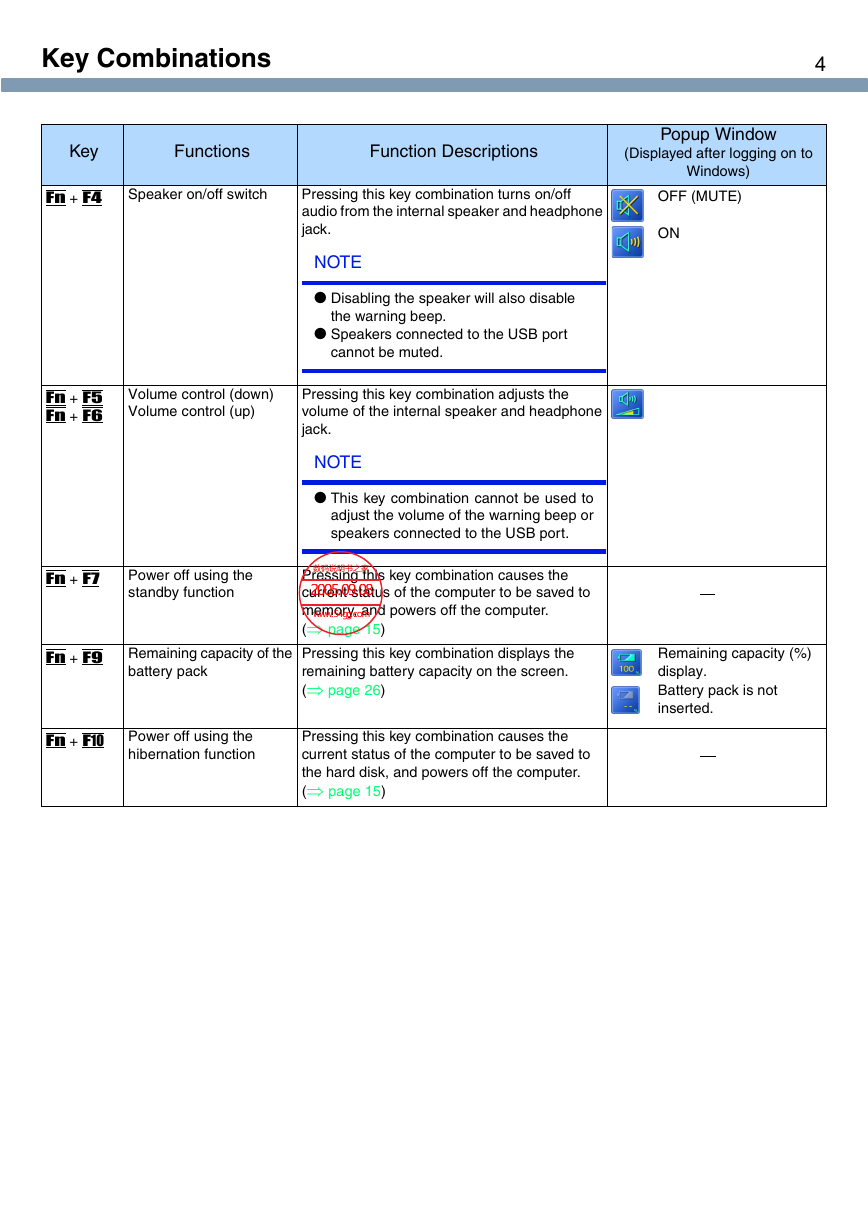
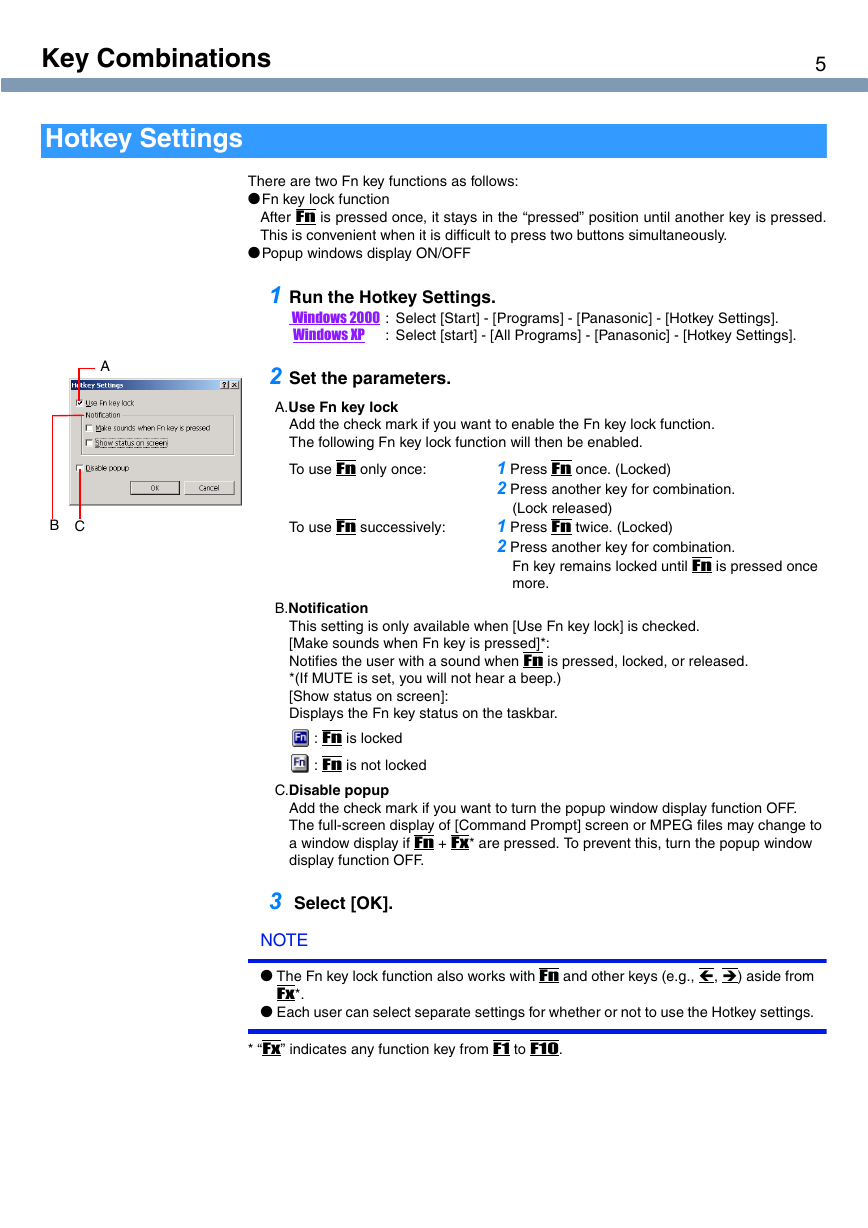
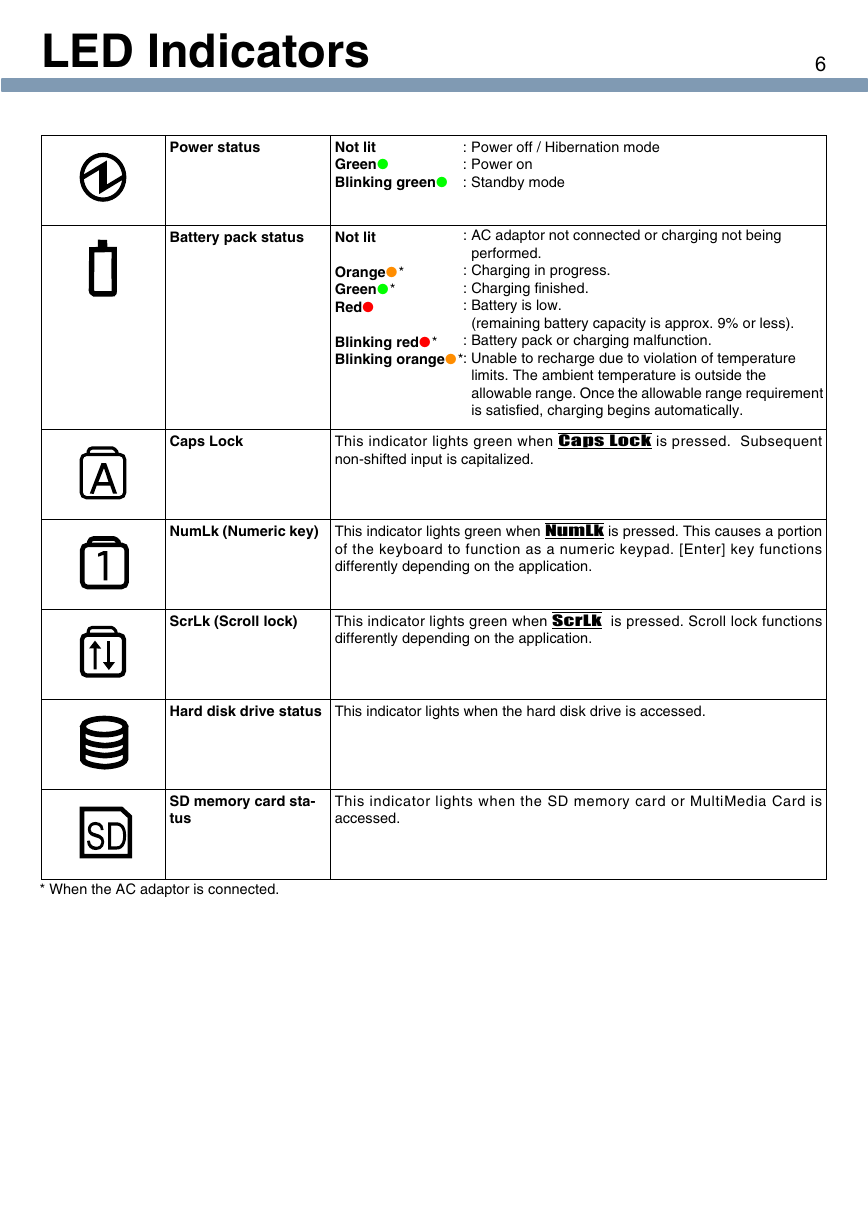

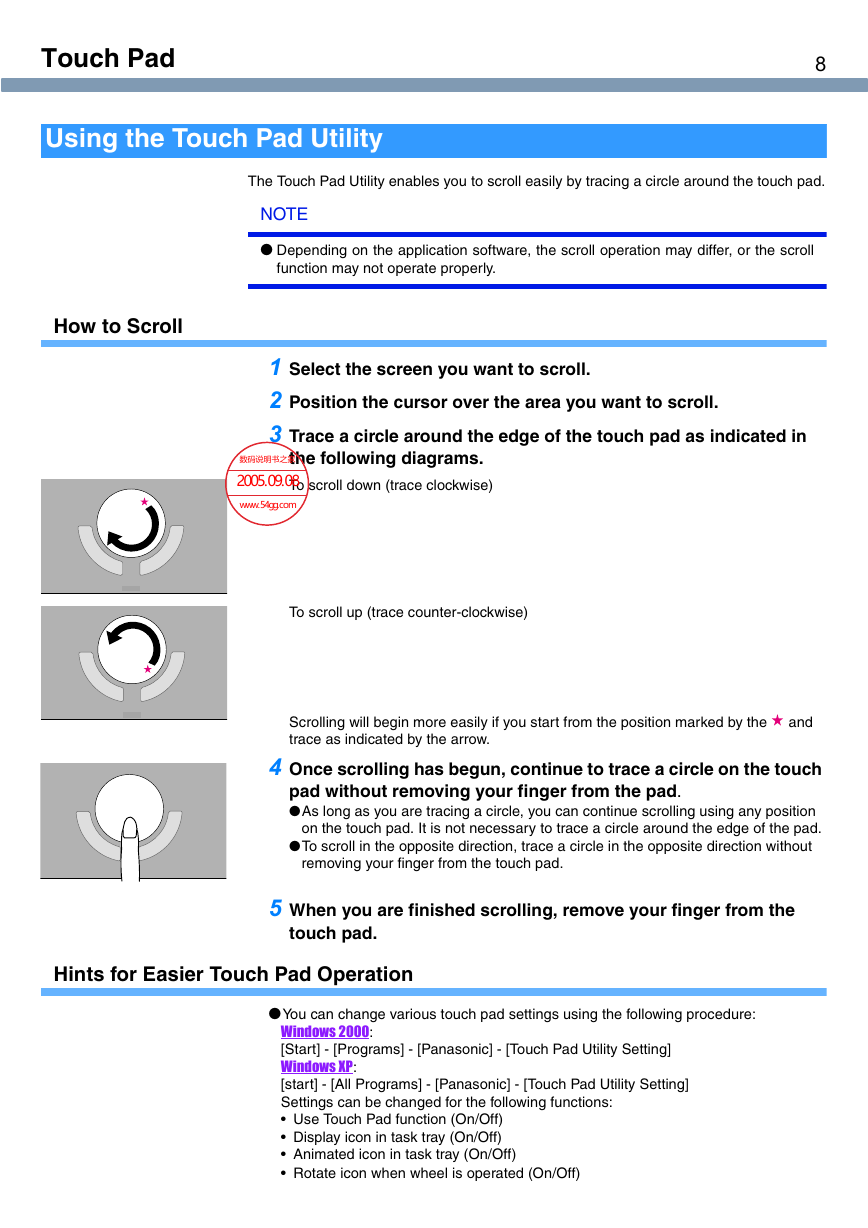








 2023年江西萍乡中考道德与法治真题及答案.doc
2023年江西萍乡中考道德与法治真题及答案.doc 2012年重庆南川中考生物真题及答案.doc
2012年重庆南川中考生物真题及答案.doc 2013年江西师范大学地理学综合及文艺理论基础考研真题.doc
2013年江西师范大学地理学综合及文艺理论基础考研真题.doc 2020年四川甘孜小升初语文真题及答案I卷.doc
2020年四川甘孜小升初语文真题及答案I卷.doc 2020年注册岩土工程师专业基础考试真题及答案.doc
2020年注册岩土工程师专业基础考试真题及答案.doc 2023-2024学年福建省厦门市九年级上学期数学月考试题及答案.doc
2023-2024学年福建省厦门市九年级上学期数学月考试题及答案.doc 2021-2022学年辽宁省沈阳市大东区九年级上学期语文期末试题及答案.doc
2021-2022学年辽宁省沈阳市大东区九年级上学期语文期末试题及答案.doc 2022-2023学年北京东城区初三第一学期物理期末试卷及答案.doc
2022-2023学年北京东城区初三第一学期物理期末试卷及答案.doc 2018上半年江西教师资格初中地理学科知识与教学能力真题及答案.doc
2018上半年江西教师资格初中地理学科知识与教学能力真题及答案.doc 2012年河北国家公务员申论考试真题及答案-省级.doc
2012年河北国家公务员申论考试真题及答案-省级.doc 2020-2021学年江苏省扬州市江都区邵樊片九年级上学期数学第一次质量检测试题及答案.doc
2020-2021学年江苏省扬州市江都区邵樊片九年级上学期数学第一次质量检测试题及答案.doc 2022下半年黑龙江教师资格证中学综合素质真题及答案.doc
2022下半年黑龙江教师资格证中学综合素质真题及答案.doc